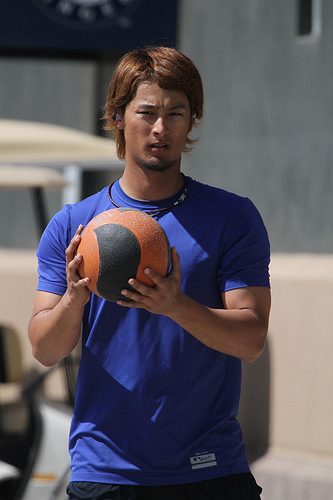- You are here:
- Home »
- Blog »
- Training »
- Medicine Ball Lunges: 5 Techniques and Variations
Medicine Ball Lunges: 5 Techniques and Variations
Lunges are one of the most popular exercises around for your lower body. While they are commonly performed with  dumbbells, barbells, or bodyweight as resistance, medicine balls can also be used. Below you will find 5 variations of medicine ball lunges.
dumbbells, barbells, or bodyweight as resistance, medicine balls can also be used. Below you will find 5 variations of medicine ball lunges.
Medicine Ball Reverse Lunges
Reverse lunges are a great alternative to traditional lunges. They are great if you are looking for variety in your training. Many argue that the reverse lunge puts your lower in a more ideal position. This can be better for both strength gains and joint health.
The video below demonstrates a version of reverse medicine ball lunges. The ball is held in front of the body and tucked just under the chin. This makes it easy to maintain good posture throughout the movement.
Medicine Ball Side Lunges
Side lunges are an important but often overlooked lower body exercise. It is important to work you muscles laterally and not just forward and back. This makes it a useful exercise for athletes or anyone else looking to improve their lateral strength.
You can see what side lunges look like in the video below. Keep one foot planted in the ground while lunging out with the other leg. You can reach the ball out in front of your body to the lunging knee. This allows you to work a more complete range of motion.
Medicine Ball Overhead Lunges
Overhead lunges use the exact same lower body movement as traditional lunges. The overhead aspect makes the lift much more challenging. By holding the ball over your head, your core and other muscles have to work much harder. In this exercise, even a light med ball can feel very heavy.
This exercise also works stability and mobility in your upper body. It takes some degree of flexibility to safely hold a ball over your head. It also put extra stress on the core and especially the lower back. You can see what it looks like in the video below.
Medicine Ball Overhead Lunge Jumps
If you are strong and comfortable with traditional exercises, it might be time for you to try plyometrics. Lunge jumps are an incredibly challenging exercise, whether you use external resistance or just your body weight. The overhead version makes it nearly impossible to cheat on the exercise and only your legs are worked.
The video below demonstrates an overhead version of med ball lunge jumps. When you first try this exercise, you will want to begin with a light resistance, if any. In general, this exercise should be done with fewer reps as it is meant to be done in an explosive manner.
Walking Lunge with Twist
The standard walking lunge is another classic exercise. You can make it more challenging by incorporating a twist with the movement. This makes it both a core and leg exercise. The twist will work your lower back, obliques and abdominals.
You can see what the walking lunge twists look like in the video below. The demonstrator is holding the ball in front of his chest. He lunges forward and then twists his upper body in the direction of the front leg. You should twist as far as you safely can to work a long range of motion.
Medicine balls are a unique tool and allow you to work your muscles in a variety of ways. Rather than only doing traditional lunges, you can work the muscles in different planes of motion. You can really change the exercise by holding the ball low, in front of you, or overhead.
While it is tough to do really heavy lifting with a med ball, there is no reason you can’t mix it in occasionally. Then, you can use dumbbells or barbells for more heavy training.
You can also greatly vary the volume of your training with a medicine ball. If you have a light ball, you can get a lot of reps in for conditioning. Alternatively, you can use a plyometric like a lunge jump. This allows you to get more speed and power work in.
Medicine ball lunges are a great option for incorporating variety into you lower body training routine. They aren’t the only way to perform the exercise, but there is no reason not to mix them in from time to time.

